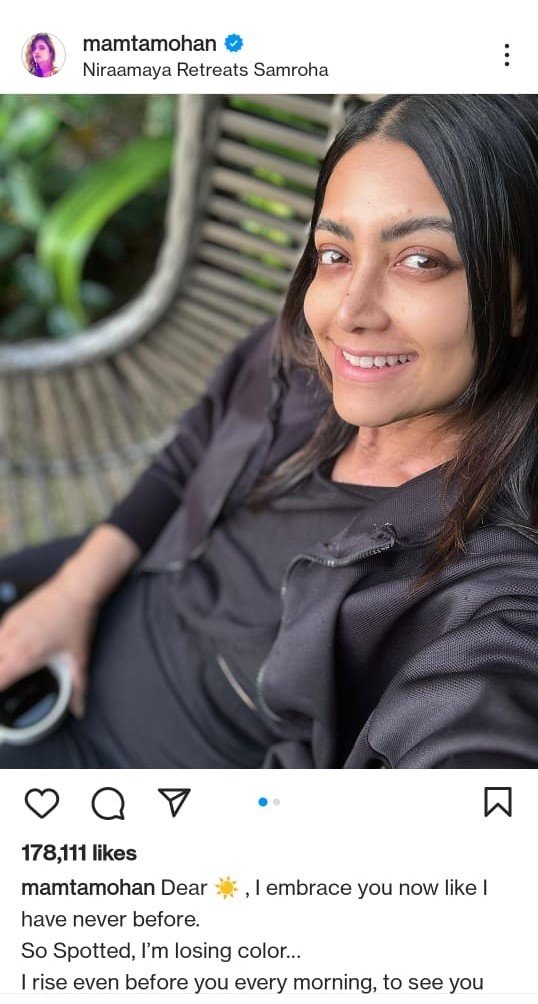Actress Mamta Mohandas diagnosed with autoimmune disease vitiligo; Here know all about the disorder
Mamta Mohandas, a prominent figure in the South, has disclosed that she had vitiligo, an autoimmune disease. The condition vitiligo causes the skin to become colorless. Vitiligo causes skin color loss in a variety of places of the body. It is frequently symmetrical, affecting both sides, such as both hands or both knees. Some people get discoloration in their mouth, on their scalp, or in their hair, lashes, or brows. For the uninitiated, Mamta is also a cancer survivor.
Mamta took to Instagram to share a few selfies and announce that she had vitiligo. “Dear Sun, I embrace you now like I have never before. So Spotted, I’m losing color… I rise even before you every morning, to see you glimmer your first ray through the haze. Give me all you’ve got.. for I will be indebted, here on out and forever by your grace” she wrote.
What is vitiligo?
Vitiligo is a chronic autoimmune condition that causes regions of skin to lose pigment or color. This occurs when melanocytes – skin cells that produce pigments – are attacked and destroyed, causing the skin to turn milky-white.

Symptoms
Vitiligo causes the skin to turn a milky-white tint, which often appears symmetrically on both sides of the body. The uncommon variety of vitiligo that affects only one side of the body, such as one leg or half the face, usually occurs at a young age and resolves after 6-12 months.
In some circumstances, people’s hair, as well as the insides of their mouths and noses, might show signs of vitiligo and become depigmented. They may also suffer itching in areas where their skin is patchy.
What is it caused by?
Vitiligo is an autoimmune illness in which the immune system of the body assaults and destroys melanocytes. Genetics and family history play a significant effect in the development of vitiligo. External factors such as sunburn, emotional distress, or chemical exposure can cause or worsen vitiligo.
How is vitiligo diagnosed?
According to the NIH, a physical examination and close study of the patient’s skin is an usual beginning point for a vitiligo diagnosis. They can also find missing melanocytes in a patient’s skin using a skin biopsy, in which they take a small sample and examine it under a microscope.
Other indirect methods of diagnosis include a blood test to rule out other autoimmune illnesses and an eye exam to rule out uveitis, an eye inflammation that can occur with vitiligo.

Prevention and treatment
Currently, there is no complete cure or preventive for vitiligo. The treatment’s goals are to restore the pigment and prevent further skin depigmentation. One of the most effective strategies to minimize depigmentation and damage is to limit sun exposure.
Treatment Options
- To restore color, use topical medicated creams or drugs containing corticosteroids or calcineurin inhibitors.
- Phototherapy, or the use of light or laser treatments to treat specific vitiligo areas. However, the National Health Service in the United Kingdom only recommends this if other treatments are ineffective due to cancer risks.
- Depigmentation, or the intentional removal of dark areas of skin to match the white patches, is used when vitiligo affects more than half of the body.
- Some people with stable vitiligo may be candidates for surgery if light therapy and medications have not worked.
Facts on vitiligo
- Vitiligo can affect people of any age, gender, or ethnicity.
- There is no cure, and the condition is usually permanent.
- The precise cause is unknown, but it could be an autoimmune disorder or a virus.
- Vitiligo does not spread.
- In severe cases, treatment may include exposure to UVA or UVB light and skin depigmentation.
Mamta is the second actress, after Samantha Ruth Prabhu, to be diagnosed with an autoimmune disease. In November of last year, the Yashoda actress revealed that she had been diagnosed with myositis and was undergoing immunity-boosting therapy in Hyderabad. Mamta was last seen in Prithviraj Sukumaran’s 2022 hit film ‘Jana Gana Mana,’ in which she played a pivotal role.
Follow WalPencil to get to know more articles like

